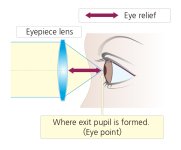ShengTu Optics
Member

Some novice friends received the telescope and were full of expectations but did not know how to operate it. They did not adjust it properly, so the images did not overlap during observation, there were shadows in the field of view, and they could not adjust it clearly at the same time. So I started a post to introduce to everyone how to use binoculars and what precautions to take.
Binoculars on the market are generally divided into roof structure and Porro structure. In fact, the operation methods are roughly the same. Take the following Forester 8X42 high-end roof telescope and Porro 8X40 standard version as examples.
First step: twist up the eye mask
If you don’t wear glasses, twist up the eye mask; if you wear glasses, twist down the eye mask.

Schematic diagram:( left picture shows a user without glasses,right picture shows the user wearing glasses.)

Folding eye mask:
Friends who do not wear glasses do not need to fold it, and friends who wear glasses can fold the eye mask down when observing.

This is done to keep the eye and the eyepiece at an appropriate exit pupil distance. If you are too close or too far away, you will feel a dark shadow moving in your field of vision and will not be able to obtain a complete circle of vision.


In addition, if the eye cup is not rotated up when observing, the eyelashes can easily scratch the eyepiece lens and contaminate it with grease, affecting the image clarity, and the image will appear foggy and blurry during observation.(The arrow in the picture points to grease)

Second step: Adjust the interpupillary distance
Many people say that they always see two circles with a black shadow in the middle, and the images cannot overlap. That is because the interpupillary distance is not adjusted properly. Operation method: adjust the distance between the two tubes to match your eye interpupillary distance, so that the images can overlap.
Some newbies do not know what interpupillary distance is or how to adjust it, so here are some schematic diagrams:
Human eye interpupillary distance: Telescope pupil distance:



People of different ages have different pupil distances. For example, children have a relatively small pupil distance, while adults have a relatively large pupil distance. Adjust the distance between the two tubes to match the pupil distance of the eyes, so that the images can overlap and there will be no shadows when observing.


Third Step: Focus
Slowly turn the focus wheel to adjust the focus and clarity

Supplementary parallax adjustment:
Some people have different degrees of vision in their two eyes, for example, 100 degrees in the left eye and 300 degrees in the right eye. After taking off the glasses, you will find that both eyes cannot see clearly at the same time. This is because the two eyes have parallax. At this time, you can first turn the middle focus wheel to make the left eye clear, and then slowly turn the right eyepiece or fine-tune the parallax compensation, and both eyes can observe a clear image at the same time. The parallax adjustment for the same person only needs to be adjusted once. After the adjustment, you only need to turn the middle focus wheel to focus when looking at different targets at different distances.

Most Paul telescopes generally use the right eyepiece to fine-tune and compensate for parallax:

Some beginners receive a telescope and, because they are not familiar with it, they turn the right eyepiece or parallax ring to the bottom when they see it can be turned. However, if the vision of both eyes is normal and the parallax is turned to the bottom, then no matter how you turn the focus wheel, one side will always be blurry, and you cannot get a clear image at the same time. So everyone should also pay attention to this point. Generally speaking, if you can see clearly at the same time, do not move the parallax ring or turn it directly to the bottom.

I believe that after reading the above diagram, you should know how to use the telescope correctly.
Let me briefly mention a few precautions:
1. Do not use a telescope to observe the sun directly, as this will cause serious damage to the eyes or even blindness.
2. Do not drop the telescope to avoid vibration and impact, so as to avoid the optical axis shifting and causing dizziness during observation.
3. Do not touch the lens with your hands to avoid grease fingerprints on the lens that affect the image clarity.
4. Do not walk while looking at the telescope to avoid stepping on dangerous objects and causing personal injury.
5. Do not leave the telescope in a car under the scorching sun or expose it to the sun for a long time to avoid high temperatures that accelerate the aging of the rubber.
6. If the telescope is not waterproof, keep it dry for a long time. It can be placed in a sealed bag with desiccant to prevent the lens from growing mold.
7. Do not put the desiccant in the telescope where children can get it to avoid children swallowing the desiccant and causing harm.
8. After using the telescope, please cover the objective lens cover and eyepiece cover to prevent dust from falling on the lens











